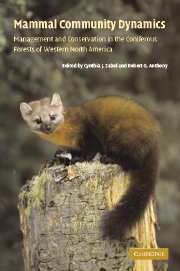 Mammal Community Dynamics
Mammal Community Dynamics Published online by Cambridge University Press: 15 December 2009
Introduction
The aquatic and terrestrial components of riparian systems provide ecological opportunities for many species of mammals. The importance of riparian habitat to wildlife populations has been documented in a wide range of habitats in North America: the midwestern United States (Stauffer and Best 1980), desert southwest (England et al. 1984), Rocky Mountains (Knopf 1985), Oregon (Anthony et al. 1987, Doyle 1990, McComb et al. 1993, Gomez and Anthony 1998, Kauffman et al. 2001), Washington (O'Connell et al. 1993, Kelsey and West 1998, Kauffman et al. 2001), and the Okanogan Highlands of British Columbia (Gyug 2000). These studies indicate that wildlife species richness is high in these ecosystems, and use of riparian zones by some species is disproportionately higher than in other areas. Although this is especially true in the more arid regions of North America (Johnson and Jones 1977, Brinson et al. 1981), this pattern can also be found in mesic forests of the Pacific Northwest. For example, Thomas et al. (1979) report that 285 of the 378 terrestrial wildlife species in the Blue Mountains of Oregon and Washington are found exclusively or more commonly in riparian areas, and Oakley et al. (1985) report similar patterns of 359 of the 414 wildlife species using riparian zones of western Washington and Oregon forests. Kauffman et al. (2001) estimate that 53% of the 593 wildlife species that occur in Washington and Oregon use riparian zones, whereas riparian zones and wetlands constitute only 1% to 2% of the landscape.
To save this book to your Kindle, first ensure [email protected] is added to your Approved Personal Document E-mail List under your Personal Document Settings on the Manage Your Content and Devices page of your Amazon account. Then enter the ‘name’ part of your Kindle email address below. Find out more about saving to your Kindle.
Note you can select to save to either the @free.kindle.com or @kindle.com variations. ‘@free.kindle.com’ emails are free but can only be saved to your device when it is connected to wi-fi. ‘@kindle.com’ emails can be delivered even when you are not connected to wi-fi, but note that service fees apply.
Find out more about the Kindle Personal Document Service.
To save content items to your account, please confirm that you agree to abide by our usage policies. If this is the first time you use this feature, you will be asked to authorise Cambridge Core to connect with your account. Find out more about saving content to Dropbox.
To save content items to your account, please confirm that you agree to abide by our usage policies. If this is the first time you use this feature, you will be asked to authorise Cambridge Core to connect with your account. Find out more about saving content to Google Drive.